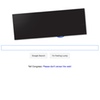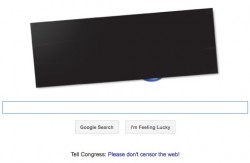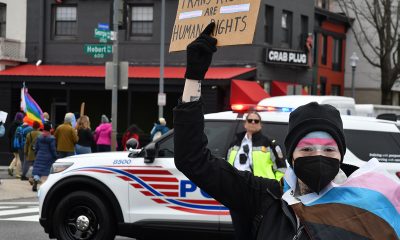National
LGBT sites join Reddit, Wikipedia in protest of SOPA
Sites see proposed piracy legislation as threat to internet, ‘go dark’ together today to raise awareness


Google has censored its logo today in an effort to raise awareness about the effects of proposed piracy legislation. Several LGBT sites have joined the protest. (screen shot of Google.com homepage)
The threat of passage of the Stop Online Piracy Act (SOPA) has led sites across the internet — including some LGBT — to go dark today in protest of the legislation backed by the Recording Industry Association of America and the Motion Picture Association of America, as well as dozens of companies from Wal-Mart to CBS.
SOPA and its Senate counterpart the PROTECT IP Act (PIPA) seek to curb online piracy by requiring internet service providers to block access to domains of foreign sites that are suspected of offering users access to pirated content. This means that sites like Pirate Bay — which allow users to share access to pirated movies and music — could be blocked if they are found to have copyright violations. However, the law could also put in jeopardy sites like YouTube, where budding artists like Justin Bieber have turned to post cover versions of copyrighted songs in hopes of making it big, as well as users who post T.V. and movie clips in fan videos, or users who use popular music as the background to home videos, such as wedding videos. YouTube uses a link shortener ‘youtu.be’ which is registered in Belgium, putting YouTube in jeopardy of having violated the law for not removing videos like this:
The law in its current form states sites would have five days to pull down links to the content before a judge can order them darkened, which could cause massive problems for many sites in the U.S.
Also in jeopardy would be social sites where users often post links and video to their news feed that could potentially violate the law. Under SOPA and PIPA, Facebook and Twitter could be held liable for such violations, and a judge could order them darkened in whole or in part, though proponents of the law say that is not likely to happen. The same could happen to blogs and the websites of news organizations whose articles link to relevant material found elsewhere on the internet, which could potentially include blacklisted sites.
Finally, search engines like Google and Bing are extremely vulnerable to some of the terms of SOPA and PIPA, which compels the sites to monitor links for possible gateways to pirated material. Paypal and eBay would also be left open to possible claims through SOPA and PIPA if they allow transactions to foreign sites which may feature pirated content.
In an effort to bring attention to the potential effects of enforcing SOPA and PIPA, web news-sharing site Reddit, and internet encyclopedia Wikipedia have gone offline today to highlight what could be a possible future for sites like these if SOPA and PIPA are passed and enforced to their fullest extent. While most legal experts don’t expect Google of Facebook to be shut down under SOPA and PIPA, critics claim the broad language and lack of recourse options for sites levied with quarantine orders make SOPA a potential problem for many domestic sites on the internet that provide access to content beyond their own domain.
In an effort to stand in solidarity with Reddit and Wikipedia, LGBT operated sites like Bilerico.com, Rawstory.com, Talk About Equality, The New Civil Rights Movement, and LGBTPOV.com have gone dark today. In addition, Google has redesigned its homepage to censor its logo, and offer options to contact lawmakers.
LGBT news site Towleroad.com placed a splash page up encouraging visitors to contact their lawmakers about SOPA.
“New bills in the US Congress and Senate are attempting to give the US government the ability to censor and shut down websites without due process,” the splash page reads. “It’s crucial we speak up to stop these bills from becoming law.”
Though users can still view the site’s content, all visitors to the site will be greeted with the unique splash page today, reminding fans that resources like Towleroad would be in danger of going dark if claims under SOPA are brought against the site.
The White House
‘Trump Rx’ plan includes sharp cuts to HIV drug prices
President made announcement on Friday

President Donald Trump met with leaders from some of the world’s largest pharmaceutical companies at the White House on Friday to announce his new “Trump Rx” plan and outline efforts to reduce medication costs for Americans.
During the roughly 47-minute meeting in the Roosevelt Room, Trump detailed his administration’s efforts to cut prescription drug prices and make medications more affordable for U.S. patients.
“Starting next year, American drug prices will come down fast, furious, and will soon be among the lowest in the developed world,” Trump said during the meeting. “For decades, Americans have been forced to pay the highest prices in the world for prescription drugs by far … We will get the lowest price of anyone in the world.”
Trump signed an executive order in May directing his administration “to do everything in its power to slash prescription drug prices for Americans while getting other countries to pay more.”
“This represents the greatest victory for patient affordability in the history of American health care, by far, and every single American will benefit,” he added.
Several pharmaceutical executives stood behind the president during the announcement, including Sanofi CEO Paul Hudson, Novartis CEO Vas Narasimhan, Genentech CEO Ashley Magargee, Boehringer Ingelheim (USA) CEO Jean-Michel Boers, Gilead Sciences CEO Dan O’Day, Bristol Myers Squibb General Counsel Cari Gallman, GSK CEO Emma Walmsley, Merck CEO Robert Davis, and Amgen Executive Vice President Peter Griffith.
Also in attendance were Health and Human Services Secretary Robert F. Kennedy Jr., Commerce Secretary Howard Lutnick, Centers for Medicare and Medicaid Services Administrator Mehmet Oz, and Food and Drug Administration Commissioner Marty Makary.
Under the Trump Rx plan, the administration outlined a series of proposed drug price changes across multiple companies and therapeutic areas. Among them were reductions for Amgen’s cholesterol-lowering drug repatha from $573 to $239; Bristol Myers Squibb’s HIV medication reyataz from $1,449 to $217; Boehringer Ingelheim’s type 2 diabetes medication jentadueto from $525 to $55; Genentech’s flu medication xofluza from $168 to $50; and Gilead Sciences’ hepatitis C medication epclusa from $24,920 to $2,425.
Additional reductions included several GSK inhalers — such as the asthma inhaler advair diskus 500/50, from $265 to $89 — Merck’s diabetes medication januvia from $330 to $100, Novartis’ multiple sclerosis medication mayzent from $9,987 to $1,137, and Sanofi’s blood thinner plavix from $756 to $16. Sanofi insulin products would also be capped at $35 per month’s supply.
These prices, however, would only be available to patients who purchase medications directly through TrumpRx. According to the program’s website, TrumpRx “connects patients directly with the best prices, increasing transparency, and cutting out costly third-party markups.”
Kennedy spoke after Trump, thanking the president for efforts to lower pharmaceutical costs in the U.S., where evidence has shown that drug prices — including both brand-name and generic medications — are nearly 2.78 times higher than prices in comparable countries. According to the Pharmaceutical Research and Manufacturers of America, roughly half of every dollar spent on brand-name drugs goes to entities that play no role in their research, development, or manufacturing.
“This is affordability in action,” Kennedy said. “We are reversing that trend and making sure that Americans can afford to get the life-saving solutions.”
Gilead CEO Dan O’Day also spoke about how the restructuring of drug costs under TrumpRx, combined with emerging technologies, could help reduce HIV transmission — a virus that, if untreated, can progress to AIDS. The LGBTQ community remains disproportionately affected by HIV.
“Thank you, Mr. President — you and the administration,” O’Day said. “I think this objective of achieving the commitment to affordability and future innovation is extraordinary … We just recently launched a new medicine that’s only given twice a year to prevent HIV, and we’re working with Secretary Kennedy and his entire team, as well as the State Department, as a part of your strategy to support ending the epidemic during your term.
“I’ve never been more optimistic about the innovation that exists across these companies and the impact this could have on America’s health and economy,” he added.
Trump interjected, asking, “And that’s working well with HIV?”
“Yes,” O’Day replied.
“It’s a big event,” Trump said.
“It literally prevents HIV almost 100 percent given twice a year,” O’Day responded.
A similar anti-HIV medication is currently prescribed more than injectable form mentioned by O’Day. PrEP, is a medication regimen proven to significantly reduce HIV infection rates for people at high risk. Without insurance, brand-name Truvada can cost roughly $2,000 per month, while a generic version costs about $60 per month.
Even when medication prices are reduced, PrEP access carries additional costs, including clinic and laboratory fees, office visits, required HIV and sexually transmitted infection testing, adherence services and counseling, and outreach to potentially eligible patients and providers.
According to a 2022 study, the annual total cost per person for PrEP — including medication and required clinical and laboratory monitoring — is approximately $12,000 to $13,000 per year.
The TrumpRx federal platform website is now live at TrumpRx.gov, but the program is not slated to begin offering reduced drug prices until January.
The White House
EXCLUSIVE: Democracy Forward files FOIA lawsuit after HHS deadnames Rachel Levine
Trans former assistant health secretary’s name changed on official portrait

Democracy Forward, a national legal organization that works to advance democracy and social progress through litigation, policy and public education, and regulatory engagement, filed a lawsuit Friday in federal court seeking to compel the U.S. Department of Health and Human Services to release information related to the alteration of former Assistant Secretary for Health Adm. Rachel Levine’s official portrait caption.
The lawsuit comes in response to the slow pace of HHS’s handling of multiple Freedom of Information Act requests — requests that federal law requires agencies to respond to within 20 working days. While responses can take longer due to backlogs, high request volumes, or the need for extensive searches or consultations, Democracy Forward says HHS has failed to provide any substantive response.
Democracy Forward’s four unanswered FOIA requests, and the subsequent lawsuit against HHS, come days after someone in the Trump-Vance administration changed Levine’s official portrait in the Hubert H. Humphrey Building to display her deadname — the name she used before transitioning and has not used since 2011.
According to Democracy Forward, HHS “refused to release any records related to its morally wrong and offensive effort to alter former Assistant Secretary for Health Admiral Rachel Levine’s official portrait caption.” Levine was the highest-ranking openly transgender government official in U.S. history and served as assistant secretary for health and as an admiral in the U.S. Public Health Service Commissioned Corps from 2021 to 2025.
Democracy Forward President Skye Perryman spoke about the need to hold the Trump-Vance administration accountable for every official action, especially those that harm some of the most targeted Americans, including trans people.
“The question every American should be asking remains: what is the Trump-Vance administration hiding? For an administration that touts its anti-transgender animus and behavior so publicly, its stonewalling and silence when it comes to the people’s right to see public records about who was behind this decision is deafening,” Perryman said.
“The government’s obligation of transparency doesn’t disappear because the information sought relates to a trailblazing former federal official who is transgender. It’s not complicated — the public is entitled to know who is making decisions — especially decisions that seek to alter facts and reality, erase the identity of a person, and affect the nation’s commitment to civil rights and human dignity.”
“HHS’s refusal to respond to these lawful requests raises more serious concerns about transparency and accountability,” Perryman added. “The public has every right to demand answers — to know who is behind this hateful act — and we are going to court to get them.”
The lawsuit also raises questions about whether the alteration violated federal accuracy and privacy requirements governing Levine’s name, and whether the agency improperly classified the change as an “excepted activity” during a lapse in appropriations. By failing to make any determination or produce any records, Democracy Forward argues, HHS has violated its obligations under federal law.
The case, Democracy Forward Foundation v. U.S. Department of Health and Human Services, was filed in the U.S. District Court for the District of Columbia. The legal team includes Anisha Hindocha, Daniel McGrath, and Robin Thurston.
The Washington Blade reached out to HHS, but has not received any comment.
The lawsuit and four FOIA requests are below:
The White House
Empty seats, canceled shows plague Kennedy Center ahead of Trump renaming
It would take an act of Congress to officially rename the historic music venue, despite the Trump-appointed board’s decision.

The board of the Kennedy Center in Washington, D.C., voted to rename it the Trump-Kennedy Center, according to the White House Press Office.
White House Press Secretary Karoline Leavitt announced the decision in a post on X Thursday, thanking the president for his work on the cultural center “not only from the standpoint of its reconstruction, but also financially, and its reputation.”
Speaking to reporters later that day at the White House, Trump said he was “surprised” and “honored” by the board’s vote.
“This was brought up by one of the very distinguished board members, and they voted on it, and there’s a lot of board members, and they voted unanimously. So I was very honored,” he said.
Earlier this year, GOP Rep. Mike Simpson of Idaho introduced an amendment that would have renamed the building after first lady Melania Trump, later saying she had not been aware of his efforts prior to the amendment’s public introduction.
Despite the board’s vote (made up of Trump-appointed loyalists), the original laws guiding the creation of the Kennedy Center during the Eisenhower, Kennedy, and Johnson administrations explicitly prohibit renaming the building. Any change to its name would require an act of Congress.
Trump has exerted increasing control over the center in recent months. In February, he abruptly fired members of the Kennedy Center’s board and installed himself as chair, writing in a Truth Social post at the time, “At my direction, we are going to make the Kennedy Center in Washington D.C., GREAT AGAIN.”
In that post, Trump specifically cited his disapproval of the center’s decision to host drag shows.
He later secured more than $250 million from the Republican-controlled Congress for renovations to the building.
Since Trump’s takeover, sales of subscription packages are said to have declined, and several touring productions — including “Hamilton” — have canceled planned runs at the venue. Rows of empty seats have also been visible in the Concert Hall during performances by the National Symphony Orchestra.
“The Kennedy Center Board has no authority to actually rename the Kennedy Center in the absence of legislative action,” House Minority Leader Hakeem Jeffries told reporters.
For decades, the Kennedy Center has hosted performances by LGBTQ artists and companies, including openly queer musicians, choreographers, and playwrights whose work helped push LGBTQ stories into the cultural mainstream. Those artists include the Gay Men’s Chorus of Washington, Harvey Fierstein, and Tennessee Williams.
In more recent years, the center has increasingly served as a space for LGBTQ visibility and acceptance, particularly through Pride-adjacent programming and partnerships.
That legacy was on display at this year’s opening production of Les Misérables, when four drag performers — Tara Hoot, Vagenesis, Mari Con Carne, and King Ricky Rosé — attended in representation of Qommittee, a volunteer network uniting drag artists to support and defend one another amid growing conservative attacks.
“We walked in together so we would have an opportunity to get a response,” said Tara Hoot, who has performed at the Kennedy Center in full drag before. “It was all applause, cheers, and whistles, and remarkably it was half empty. I think that was season ticket holders kind of making their message in a different way.”
The creation of the Kennedy Center is outlined in U.S. Code, which formally designates the institution as the John F. Kennedy Center for the Performing Arts.
As a result, it appears unlikely that Congress will come together to pass legislation allowing the historic venue to be renamed.
-

 Politics2 days ago
Politics2 days agoLGBTQ Democrats say they’re ready to fight to win in 2026
-

 District of Columbia2 days ago
District of Columbia2 days agoBrian Footer suspends campaign for Ward 1 D.C. Council seat
-

 Chile4 days ago
Chile4 days agoFar-right José Antonio Kast elected Chile’s next president
-

 Opinions2 days ago
Opinions2 days agoLighting candles in a time of exhaustion




















